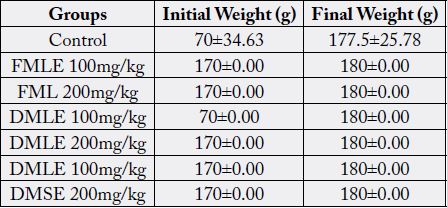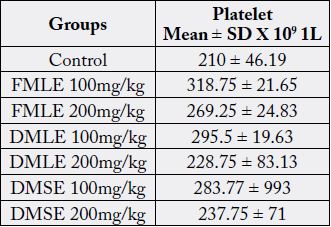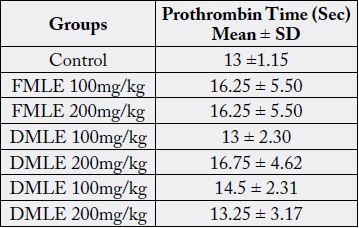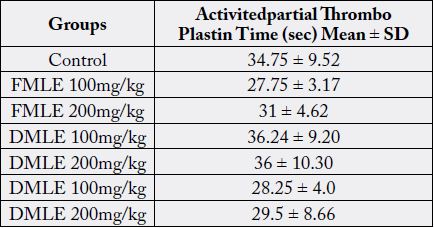Biography
Interests
Okorie Hope & Obeagu Emmanuel Ifeanyi*
Department of Medical Laboratory Science, Imo State University, Owerri, Nigeria
*Correspondence to: Obeagu Emmanuel Ifeanyi, Department of Medical Laboratory Science, Imo State University, Owerri, Nigeria.
Copyright © 2019 Obeagu Emmanuel Ifeanyi, et al. This is an open access article distributed under the Creative Commons Attribution License, which permits unrestricted use, distribution, and reproduction in any medium, provided the original work is properly cited.
Abstract
The effect of moringa oleifera leaf and seed extracts was studied on body weight, and some coagulation parameters of albino rats. Oral administration of 100 and 200mg/kg bodyweight of the rats for 2weeks caused duration and dose. The results revealed a statistically mean difference which is higher platelet counts and higher in prothrombin time and lower in activated partial thromboplastin time in rats treated with fresh moringa leaf extract, dry moringa leaf extract, dry moringa seed extract. There was no significant change in the body weight of rats treated for 2weeks with moringa oleifera leaf and seed extract. Platelet count (210 ± 46.19) and prothrombin time (13± 1.15) were significant increased (p<0.05) in rats treated with 100mg/kg of moringa oleifera leaf and seed extract when compared with those of the control counterparts - (318.75 ± 21.65), (295.5± 19.63) (269.25± 99.3), (16.5± 3.46), (13. ± 2.3), (14.5± 2.31) respectively. With 200mg1kg of the extracts, platelet count (269.25 ± 24.83), (228.75±83.13), (237.75± 71.88) prothombin time (16.25±5.5), (16.75±4.62), (13.25± 3.17) were significantly increased when compared with their control counterparts and those treated with 100mg 1kg. activated partial thromboplastin time (34.75± 9.52) was significantly decreased in rats treated with 100mg 1kg when compared with those of the control (31±4.62), (36.25±9.2), (28.25± 3.117), (36±10.36) and (29.5± 8.66) respectively. These results suggest that moringa oleifera extracts have contains thrombin like enzyme.
Introduction
Coagulation (thrombogensis) is the process by which blood forms clots. It is an important part of hemostasis,
the cessation of blood loss from a damaged vessel, wherein a damaged blood vessel wall is covered by a
platelet and fibrin-containing clot to stop bleeding and begin repair of the damaged vessels. Disorders of
coagulation can lead to an increased risk of bleeding (haemorrhage) or obstructive clothing [1].
The central event in the coagulation pathways is the production of thrombin, which acts upon fibrinogen to produce fibrin and thus the fibrin clot. This clot is further strengthened by the crosslinking action of factor XIII, which itself is activated by thrombin. The two commonly used coagulation tests, the activated Partial Thromboplastin Time (APTT) and the prothrombin time (PT), have been used historically to define two pathways of coagulation activation: the intrinsic and extrinsic paths, respectively. However, this bears only a limited relationship to the way coagulation is activated in vivo for example, deficiency of factor XII or of factor VIII both produce marked prolongation of the APTT, but only deficiency of the latter is associated with a hemorrhagic tendency. Moreover there is marked considerable evidence that activation of factor IX (Intrinsic pathway) by factor VII (extrinsic pathway) is curial to establishing coagulation after an initial stimulus has been provided by factor viia-tissue factor (IT) activation of factor X [2].
The Prothrombin Time (PT) is a test that measures the trinsic pathway of coagulation. When tissue thromboplastin and alcium ions are added to plasma, trinsic clothing factors ie activated, resulting in the generation of thrombin and the formation of fibrin clot. Thus, the test indicates functions of factors II, V, VII and X [3].
Activated Partial Thromboplastin Time (APTT) is a tet used to demonstrate deficiencies within the intrinsic pathway, and the final common pathway. The clothing time is affected by all bon factor except factor VII and platelet factor 3 [3].
Platelets are an essential part of blood coagulating mechanism. They act as plugs around the opening of a wound Tease certain factors that are necessary for the formation of blood clot to prevent blood loss. The platelets also maintain the integrity of the blood vessels by plugging the gaps in endothelial lining [3]. They are incapable of mitotic division because they lack nuclus and have no DMA. The megakaryocte matures by end mitotic synchrous nuclear replication enlarging the cytoplasmic volume number of nuclear cubes increase in multiple of most wily at the eight nucleus stage they cytoplasms becomes granular and platelets are librated. It is 2.5um in diameter [4].
Moringa oleifera is a free of the Moringaceae family, widely mil throughout the tropics and subtropics and subtropics and its leaves, seed pods, seed, seed oil, root, bark, flowers and are commonly consumed as food and used in traditional medicines. Its use as an inexpensive component in foods nutritional supplements or medicines by patients with HIV/AIDS has been advocated by several African Governments [5]. It possesses anti-inflamentaory, antioxidant, antimicrobial, antifertility, anticancer, antihepatotoxic, antiulcer activities, [6], some researchers reported its hypoglycaemic potential [7], inhibition of Epstein-Barr virus activity invitro [8].
According to Fugie 1999 the many uses for Moringa include: alley cropping (biomass production), animal forage leaves and treated seed-cake), biogas (from leaves) domestic cleaning agent (crushed leaves), blue foliar (wood), fencing (living tree), fertilizer (seed cake), foliar nutrient (juice expressed from the leave, green manure from leaves), gum (from tree truncks), honey and sugar cane juice-clarifier (powdered seed), honey (flower nectar) biopesticide (soil incorporation of leaves to prevent seedling damping off), pulp (wood), rope (bark), tannin for tanning hides (bark and gum), water purification (powdered seed). Moringa see oil (yield 43% by weight). It is net to olive oil in terms of quality [9] can be used in salad, one can chop the pods into bits and take them with rice [10]. It has been used for fine machine lubrication and in the manufacture of perfume and hair care products [11]. In the west, one of the besk known uses of Moringa is the use of powdered seeds to flocculate contaminants and purify drinking water, the seeds are considered to be better than the commonly used tauter purifier, aluminum sulfate which is slightly toxic to the nervous system when used repeatedly [12].
Moringa can be taken to elimate stress. If you put most of the synthetic medicine used for stress-related cases, you will find but Moringa contain all, this shows that Moringa is a natural plant and not a synthetic by product [13].
Reports have shown that the products of traditionally used taints such as Bryophyllumnnatum and and M. Oleifera promoted ling in experimental animals [14,15]. The M. Oleifera roots and seeds are prescribed treatment of snake bites and scorpion stings [16]. M. Oleifera can be used in traditional medicine as an toaugulant due to it procoagulant activity/fibrinogenolytic.
Methodology
0.1ml of plasma was delivered into glass tube placed in a water bath and 0.1ml of thromoboplastin was added.
The mixture was allowed to stary for 2 minutes to be warm at 37ºc. then 0.1ml of warm CaCl2 was added and stop watch parted. The content of the tube was mixed formation. The stop watch was stopped at the first sign of clot and the time for the plasma to clot was noted. The test pas carried out in duplicate on the test and control plasma.
Equal volumes of the phospholipids reagent and the kaolin was mixed and left in a glass tube in the water bath at 37ºC. 0.1ml. of plasma was placed into a second glass tube.
0.2ml of the kaolin-phospholipid solution was added to plasma. The content was mixed and stop watch started simultaneously. It was left at 37ºC for 10mins with occasional raking. At exactly 10mins, 0.1ml of prewarmed CaC12 was added and second stop watch started. The test was repeated nee on bath the test plasma and the control plasma.
0.38ml of the diluents was dispensed into a test tube using a asjyeur pipette, wit the help of a micro pipette 0.02ml of pod was added to the diluents. It was allowed to stand for 5 minutes for proper mixture (making it 1 in 20 dilution). A cover slip was placed in the middle of the counting chamber and gently pressed down until a newton appeared (i.e. charging chamber).
A drop of the dilution made was placed at the edge of the cover slip using a pasteuspipptte, and the solution was allowed to sparead before commencing counting. The counting chamber was placed under the microscope and viewed using x10 and x40 objectives respectively. The platelets in five corners of the chamber were counted.
Calculation

DMLE- Dry Moringa Leaf Extract
FMLE- Fresh Moringa Leaf Extract
DMSE- Dry Moringa Seed Extract

FMLE - Fresh Moringa Leaf Extract
DMLE - Dry Moringa Leaf Extract
DMSE - Dry Moringa Seed Extract

FMLE - Fresh Moringa Leaf Extract
DMLE - Dry Moringa Leaf Extract
DMLE - Dry Moringa Leaf Extract

FMLE - Fresh Moringa Leaf Extract
DMLE - Dry Moringa Leaf Extract
DMSE - Dry Moringa Seed Extract
Result Interpretation
The platelet count was significantly increased in rats treated with DMSE with values of 283.75 ± 99.30 and
235.75 ± 71.88 x 1091L than those of the control 210 ± 46.19 while those treated with FMLE and DMLE
with values of 318.75 ± 21.65, 269.25 ± 24.83, 295.50 ± 24.83 have a reduced platelet count compare to the
control.
The prothrombin time was significantly prolonged in rats treated with both the leaf and the seed extract of moringaoleifera compared to their controls. The PT was more prolonged in rats treated with 200mg/kg FMSE with values of 16.25 ± 5.5.
The activated partial thromboplatin time was significantly decreased in rats treated with FMLE and DMSE compared to the controls but was significantly prolonged in rats treated with DMLE.
The activated partial thromboplastin time was more prolonged in rats treated with 200mg/kg of DMLE with values of 36 ± 10.39 compare to 36.25 ± 9.52.
Discussion
The results from this study suggest that extracts of moringaoleifera leaf and seed could be used as an anticoagulant
in traditional medicine. The activated partial thromboplastin time was decreased.
This is in agreement with the report of LUZ et al. 20113 that coagulant moringaoleiferalectin acted as an anticoagulant protein on invitro blood coagulation parameters and at least activated partialthromboplastin time.
The result of the analysis showed that there is statistically signifant (p<0.05) mean difference in the platelet count, prothrombin time and activated partial thrombplastin time in rats treated with moringaoleifera leaf and seed extracts.
Though, these values are within the normal range reference range acceptable physiologically, the difference in their mean is taught to be caused by higher dose of the extract as seen in table 2. Rats given 200mg/ kg DMLE had a platelet count of 228.75 = 83.13. prothrombin time of 16.75 = 4.62 and activated partial throrombin time of 36 = 10.39 and probably because calcium as one of the coagulation factors is higher in DMLE than in FMLE.
Conclusion
Based on the research findings and result obtained from the analysis, it was observed that DMLE had
more effect on platelet count, prothrombin time and activated partial thromboplastin time. DMLE decrease
the platelet count and increased the prothrombin time and activated partial thromboplastin time and
prothrombin time. FMLE increased the platelet count and prothrombin time but decreased the activated
partial thromboplastin time. The results suggest the involvement/presence of thrombin in moringa oleifera
leaf and seed.
Bibliography

Hi!
We're here to answer your questions!
Send us a message via Whatsapp, and we'll reply the moment we're available!